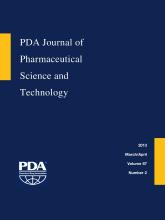Abstract
Out of the plethora of chemical species extractable at low levels from the materials of construction of single-use bioprocess containers, we have identified one particularly conspicuous compound and shown it to be highly detrimental to cell growth. The compound, bis(2,4-di-tert-butylphenyl)phosphate (bDtBPP), is derived from the breakdown of tris(2,4-di-tert-butylphenyl)phosphite (trade name Irgafos 168®), a common antioxidant additive present in many formulations of polyethylene (one of the polymers commonly used as the material contacting process fluids in bioprocess containers). Cell growth experiments using several mammalian cell lines and growth media spiked with bDtBPP show harmful effects at concentrations well below the parts-per-million range. Cellular response to bDtBPP is rapid, and results in a significant decrease in mitochondrial membrane potential. The migration of bDtBPP from polyethylene-based films is shown to be time- and temperature-dependent. Further, experiments suggest that exposure of oxidized Irgafos 168 to ionizing radiation (such as gamma irradiation) is an important condition for the generation of significant amounts of leachable bDtBPP.
LAY ABSTRACT: Biopharmaceuticals are drugs manufactured using cells that are genetically engineered to produce a therapeutic protein. A current trend in biomanufacturing is the replacement of hard-plumbed stainless steel vessels (where these cells are grown) with specialized, pre-sterilized, disposable plastic bags. While this move has significant environmental and cost benefits, the effect of plastics on the biomanufacturing process is not yet completely understood. Here we show that if a chemical compound formed by the breakdown of a common antioxidant additive to plastics leaches into the cell culture liquid, the growth of mammalian cells is strongly inhibited. Some of the factors that promote the generation of this compound, and the conditions that favor migration of the compound into process fluids, are explored here.
Footnotes
- © PDA, Inc. 2013
PDA members receive access to all articles published in the current year and previous volume year. Institutional subscribers received access to all content. Log in below to receive access to this article if you are either of these.
If you are neither or you are a PDA member trying to access an article outside of your membership license, then you must purchase access to this article (below). If you do not have a username or password for JPST, you will be required to create an account prior to purchasing.
Full issue PDFs are for PDA members only.
Note to pda.org users
The PDA and PDA bookstore websites (www.pda.org and www.pda.org/bookstore) are separate websites from the PDA JPST website. When you first join PDA, your initial UserID and Password are sent to HighWirePress to create your PDA JPST account. Subsequent UserrID and Password changes required at the PDA websites will not pass on to PDA JPST and vice versa. If you forget your PDA JPST UserID and/or Password, you can request help to retrieve UserID and reset Password below.






